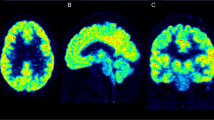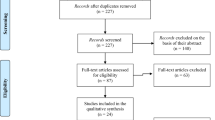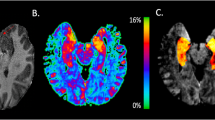Abstract
The field of medicine is moving toward the use of biomarkers for the optimization of individualized care. This is a particular challenge for the field of psychiatry, in which diagnosis is based on a descriptive collection of behaviors without the availability of any objective test to stratify patients. Neuroimaging techniques such as molecular imaging with positron-emission tomography (PET) or structural and functional magnetic resonance imaging (MRI) provide an opportunity to bring psychiatry from an era of subjective descriptive classification into objective and tangible brain-based measures. Here we provide steps toward the development of robust, reliable and valid biomarkers. The success of such development is crucial because it will enable the field of psychiatry to move forward into the era of modern medicine.
This is a preview of subscription content, access via your institution
Access options
Subscribe to this journal
Receive 12 print issues and online access
$209.00 per year
only $17.42 per issue
Buy this article
- Purchase on Springer Link
- Instant access to full article PDF
Prices may be subject to local taxes which are calculated during checkout



Similar content being viewed by others
References
Collins, F.S. & Varmus, H. A new initiative on precision medicine. N. Engl. J. Med. 372, 793–795 (2015).
Normanno, N. & Cree, I.A. Genomics driven-oncology: challenges and perspectives. BMC Cancer 15, 141 (2015).
Kalia, M. Biomarkers for personalized oncology: recent advances and future challenges. Metabolism 64 (Suppl. 1), S16–S21 (2015).
El Achkar, C.M., Olson, H.E., Poduri, A. & Pearl, P.L. The genetics of the epilepsies. Curr. Neurol. Neurosci. Rep. 15, 39 (2015).
Soni, A. in The Five Most Costly Conditions, 1996 and 2006: Estimates for the U.S. Civilian Non-institutionalized Population 1–3 (Agency for Healthcare Research and Quality, 2009).
Kessler, R.C. et al. Individual and societal effects of mental disorders on earnings in the United States: results from the national comorbidity survey replication. Am. J. Psychiatry 165, 703–711 (2008).
Van Snellenberg, J.X. et al. Mechanisms of working memory impairment in schizophrenia. Biol. Psychiatry 80, 617–626 – (2016).
Setiawan, E. et al. Role of translocator protein density, a marker of neuroinflammation, in the brain during major depressive episodes. JAMA Psychiatry 72, 268–275 (2015).
Doorduin, J. et al. Neuroinflammation in schizophrenia-related psychosis: a PET study. J. Nucl. Med. 50, 1801–1807 (2009).
van Berckel, B.N. et al. Microglia activation in recent-onset schizophrenia: a quantitative (R)-[11C]PK11195 positron emission tomography study. Biol. Psychiatry 64, 820–822 (2008).
Kenk, M. et al. Imaging neuroinflammation in gray and white matter in schizophrenia: an in vivo PET study with [18F]-FEPPA. Schizophr. Bull. 41, 85–93 (2015).
Innis, R.B. et al. Consensus nomenclature for in vivo imaging of reversibly binding radioligands. J. Cereb. Blood Flow Metab. 27, 1533–1539 (2007).
Plichta, M.M. et al. Test-retest reliability of evoked BOLD signals from a cognitive-emotive fMRI test battery. Neuroimage 60, 1746–1758 (2012).
Glasser, M.F. et al. The minimal preprocessing pipelines for the Human Connectome Project. Neuroimage 80, 105–124 (2013).
Schmaal, L. et al. Cortical abnormalities in adults and adolescents with major depression based on brain scans from 20 cohorts worldwide in the ENIGMA Major Depressive Disorder Working Group. Mol. Psychiatry http://dx.doi.org/10.1038/mp.2016.60 (2016).
Howes, O.D. et al. The nature of dopamine dysfunction in schizophrenia and what this means for treatment. Arch. Gen. Psychiatry 69, 776–786 (2012).
Demjaha, A., Murray, R.M., McGuire, P.K., Kapur, S. & Howes, O.D. Dopamine synthesis capacity in patients with treatment-resistant schizophrenia. Am. J. Psychiatry 169, 1203–1210 (2012).
Schobel, S.A. et al. Imaging patients with psychosis and a mouse model establishes a spreading pattern of hippocampal dysfunction and implicates glutamate as a driver. Neuron 78, 81–93 (2013).
Schobel, S.A. et al. Differential targeting of the CA1 subfield of the hippocampal formation by schizophrenia and related psychotic disorders. Arch. Gen. Psychiatry 66, 938–946 (2009).
Radua, J. et al. Ventral striatal activation during reward processing in psychosis: A neurofunctional meta-analysis. JAMA Psychiatry 72, 1243–1251 (2015).
Mayberg, H.S. et al. Reciprocal limbic-cortical function and negative mood: converging PET findings in depression and normal sadness. Am. J. Psychiatry 156, 675–682 (1999).
Seminowicz, D.A. et al. Limbic-frontal circuitry in major depression: a path modeling metanalysis. Neuroimage 22, 409–418 (2004).
Mayberg, H.S. et al. Deep brain stimulation for treatment-resistant depression. Neuron 45, 651–660 (2005).
Fritz, H.C. et al. Current smoking and reduced gray matter volume—a voxel-based morphometry study. Neuropsychopharmacology 39, 2594–2600 (2014).
Konova, A.B. et al. Structural and behavioral correlates of abnormal encoding of money value in the sensorimotor striatum in cocaine addiction. Eur. J. Neurosci. 36, 2979–2988 (2012).
Martinez, D. et al. Cocaine dependence and d2 receptor availability in the functional subdivisions of the striatum: relationship with cocaine-seeking behavior. Neuropsychopharmacology 29, 1190–1202 (2004).
Martinez, D. et al. Deficits in dopamine D(2) receptors and presynaptic dopamine in heroin dependence: commonalities and differences with other types of addiction. Biol. Psychiatry 71, 192–198 (2012).
Martinez, D. et al. Imaging dopamine transmission in cocaine dependence: link between neurochemistry and response to treatment. Am. J. Psychiatry 168, 634–641 (2011).
Radua, J., van den Heuvel, O.A., Surguladze, S. & Mataix-Cols, D. Meta-analytical comparison of voxel-based morphometry studies in obsessive-compulsive disorder vs other anxiety disorders. Arch. Gen. Psychiatry 67, 701–711 (2010).
Etkin, A. & Wager, T.D. Functional neuroimaging of anxiety: a meta-analysis of emotional processing in PTSD, social anxiety disorder, and specific phobia. Am. J. Psychiatry 164, 1476–1488 (2007).
Perlis, R.H. Translating biomarkers to clinical practice. Mol. Psychiatry 16, 1076–1087 (2011).
Koutsouleris, N. et al. Use of neuroanatomical pattern classification to identify subjects in at-risk mental states of psychosis and predict disease transition. Arch. Gen. Psychiatry 66, 700–712 (2009).
Cannon, T.D. et al. Prediction of psychosis in youth at high clinical risk: a multisite longitudinal study in North America. Arch. Gen. Psychiatry 65, 28–37 (2008).
Brown, M.R. et al. ADHD-200 Global Competition: diagnosing ADHD using personal characteristic data can outperform resting state fMRI measurements. Front. Syst. Neurosci. 6, 69 (2012).
Horga, G., Kaur, T. & Peterson, B.S. Annual research review: Current limitations and future directions in MRI studies of child- and adult-onset developmental psychopathologies. J. Child Psychol. Psychiatry 55, 659–680 (2014).
Marquand, A.F. et al. Dissociable effects of methylphenidate, atomoxetine and placebo on regional cerebral blood flow in healthy volunteers at rest: a multi-class pattern recognition approach. Neuroimage 60, 1015–1024 (2012).
Huys, Q.J., Maia, T.V. & Frank, M.J. Computational psychiatry as a bridge from neuroscience to clinical applications. Nat. Neurosci. 19, 404–413 (2016).
Bansal, R. et al. Anatomical brain images alone can accurately diagnose chronic neuropsychiatric illnesses. PLoS One 7, e50698 (2012).
Schnack, H.G. et al. Can structural MRI aid in clinical classification? A machine learning study in two independent samples of patients with schizophrenia, bipolar disorder and healthy subjects. Neuroimage 84, 299–306 (2014).
Laughren, T.P. What's next after 50 years of psychiatric drug development: an FDA perspective. J. Clin. Psychiatry 71, 1196–1204 (2010).
Slifstein, M. et al. Deficits in prefrontal cortical and extrastriatal dopamine release in schizophrenia: a positron emission tomographic functional magnetic resonance imaging study. JAMA Psychiatry 72, 316–324 (2015).
Addington, J. et al. North American Prodrome Longitudinal Study (NAPLS 2): The prodromal symptoms. J. Nerv. Ment. Dis. 203, 328–335 (2015).
Acknowledgements
G.H. is funded by the US National Institutes of Health (grant K23MH101637).
Author information
Authors and Affiliations
Corresponding author
Ethics declarations
Competing interests
The authors declare no competing financial interests.
Rights and permissions
About this article
Cite this article
Abi-Dargham, A., Horga, G. The search for imaging biomarkers in psychiatric disorders. Nat Med 22, 1248–1255 (2016). https://doi.org/10.1038/nm.4190
Received:
Accepted:
Published:
Issue Date:
DOI: https://doi.org/10.1038/nm.4190
This article is cited by
-
Replication of a neuroimaging biomarker for striatal dysfunction in psychosis
Molecular Psychiatry (2024)
-
Neuroimaging in psychedelic drug development: past, present, and future
Molecular Psychiatry (2023)
-
Psychosis brain subtypes validated in first-episode cohorts and related to illness remission: results from the PHENOM consortium
Molecular Psychiatry (2023)
-
Peripheral and neural correlates of self-harm in children and adolescents: a scoping review
BMC Psychiatry (2022)
-
Treatment biomarkers for ADHD: Taking stock and moving forward
Translational Psychiatry (2022)



